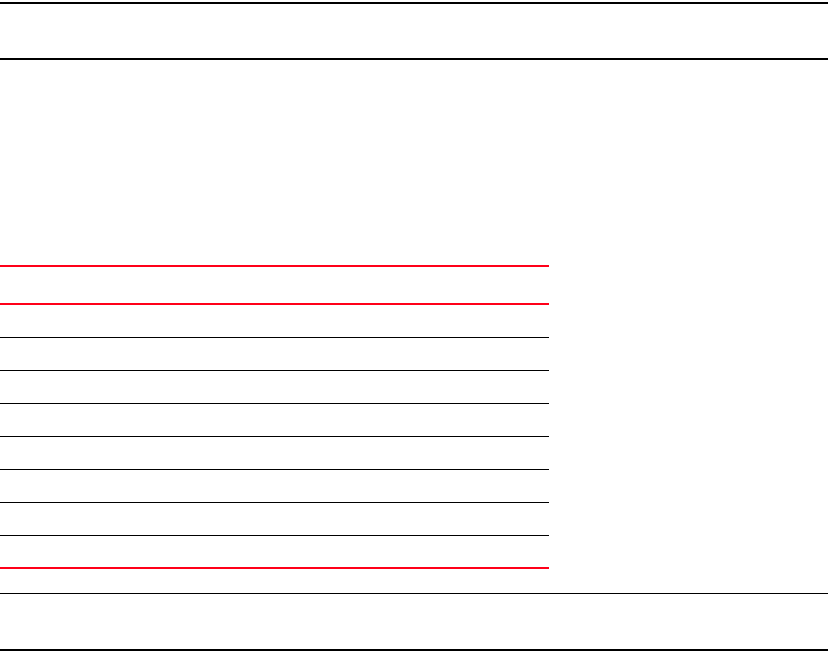Brocade Converged Enhanced Ethernet Administrator's Guide v6.1.2_cee (53-1001258-01, June 2009)
Table Of Contents
- Contents
- Figures
- Tables
- About This Document
- Introducing FCoE
- Using the CEE CLI
- In this chapter
- CEE CLI configuration guidelines and restrictions
- Using the CEE command line interface (CLI)
- CEE CLI RBAC permissions
- Accessing the CEE CLI through the console interface or through a Telnet session
- Accessing the CEE CLI from the Fabric OS shell
- Accessing CEE CLI command modes
- Using CEE CLI keyboard shortcuts
- Displaying CEE CLI commands and command syntax
- Using CEE CLI command completion
- CEE CLI command syntax conventions
- Using CEE CLI command output modifiers
- Configuring VLANs Using the CEE CLI
- In this chapter
- VLAN overview
- Ingress VLAN filtering
- VLAN configuration guidelines and restrictions
- Default VLAN configuration
- VLAN configuration procedures
- Enabling and disabling a CEE interface
- Configuring the MTU on a CEE interface
- Creating a VLAN interface
- Configuring a VLAN interface to forward FCoE traffic
- Configuring a CEE interface as a Layer 2 switch port
- Configuring a CEE interface as an access interface or a trunk interface
- Configuring VLAN classifier rules
- Configuring VLAN classifier groups
- Associating a VLAN classifier group to a CEE interface
- Clearing VLAN counter statistics
- Displaying VLAN information
- Configuring the MAC address table
- Configuring STP, RSTP, and MSTP using the CEE CLI
- In this chapter
- STP overview
- RSTP overview
- MSTP overview
- STP, RSTP, and MSTP configuration guidelines and restrictions
- Default STP, RSTP, and MSTP configuration
- STP, RSTP, and MSTP configuration procedures
- STP, RSTP, and MSTP-specific configuration procedures
- STP and RSTP-specific configuration procedures
- RSTP and MSTP-specific configuration procedures
- MSTP-specific configuration procedures
- 10-Gigabit Ethernet CEE interface-specific configuration
- Global STP, RSTP, and MSTP-related configuration procedures
- Clearing STP, RSTP, and MSTP-related information
- Displaying STP, RSTP, and MSTP-related information
- Configuring Link Aggregation using the CEE CLI
- Configuring LLDP using the CEE CLI
- Configuring ACLs using the CEE CLI
- In this chapter
- ACL overview
- Default ACL configuration
- ACL configuration guidelines and restrictions
- ACL configuration procedures
- Creating a standard MAC ACL and adding rules
- Creating an extended MAC ACL and adding rules
- Modifying a MAC ACL
- Removing a MAC ACL
- Reordering the sequence numbers in a MAC ACL
- Applying a MAC ACL to a CEE interface
- Applying a MAC ACL to a VLAN interface
- Clearing MAC ACL counters
- Displaying MAC ACL information
- Configuring QoS using the CEE CLI
- Configuring FCoE using the Fabric OS CLI
- Administering the switch
- Configuring RMON using the CEE CLI
- Index

Converged Enhanced Ethernet Administrator’s Guide 105
53-1001258-01
Queueing
8
User-priority mapping
There are several ways an incoming packet can be mapped into a user-priority. If the neighboring
devices are untrusted or unable to properly set QoS then the interface is considered untrusted and
all traffic must be user-priority mapped using explicit policies or the IEEE 802.1Q default-priority
mapping is used. If an interface is trusted to have QoS set then the CoS header field can be
interpreted.
NOTE
The user priority mapping described in this section applies to both unicast and multicast traffic.
Default user-priority mappings for untrusted interfaces
When Layer 2 QoS trust is set to untrusted then the default is to map all Layer 2 switched traffic to
the port default user priority value of 0 (best effort), unless configured to a different value.
Table 16 presents the Layer 2 QoS untrusted user priority generation table.
NOTE
Non-tagged Ethernet packets are interpreted as incoming CoS 0.
You can override the default user-priority mapping by applying explicit user-priority mappings.
When neighboring devices are trusted and able to properly set QoS then Layer 2 QoS trust can be
set to COS and the IEEE 802.1Q default-priority mapping is applied.
TABLE 16 Default priority value of untrusted interfaces
Incoming CoS User Priority
0 port <user priority> (default 0)
1 port <user priority> (default 0)
2 port <user priority> (default 0)
3 port <user priority> (default 0)
4 port <user priority> (default 0)
5 port <user priority> (default 0)
6 port <user priority> (default 0)
7 port <user priority> (default 0)










